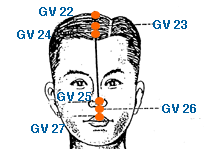GV 26 GV26 Water Trough Shui Gou 人中 governing vessel 26 Governing Vessel 26 gv26
GV 26 GV26
GV 26 GV26
GV 26 Water Trough - Shui Gou - 人中

Location
At the junction of the upper and middle third of the philtrum.
Associations
- Ghost Point
- Intersecting Point of the Governing Vessel, Large Intestine & Stomach Channels
- Command Point
Actions
- One of two Command Points (with PC 6) added to the original four, for fainting, collapse. Main point for restoring consciousness, for shock, revivial from fainting, weakness, helps patient to awaken, use fingernail in an emergency.
- Main point for acute low back sprain, helps relieve pain and restore motion, moves stagnation at the opposite end of the channel. After obtaining the Qi, have pateint bend then rotate the waist.
- Nosebleed, nasal discharge issues, problems with olfactory sensations (smell).
- Manic-depression and other strong shen disturbances, epilepsy (seizures).
GV 26 Cautions
Precautions:
- No Moxa (MX): Cautions with moxa.
For a more comprehensive list of all cautions, see our precautions and contraindications page.
Relationships
Point Categories (2)
Related Blog Posts (8)
- Acupuncture Accelerates Recovery from General Anesthesia
- Acupuncture Faster with Less Side Effects Than Prozac for Post-Stroke Depression (Study)
- Acupuncture Treatment Helpful for Trigeminal Neuralgia
- Awakening a Child From a Vegetative State with Xing Nao Kai Qiao Acupuncture
- Electro-Acupuncture May Aid Substances To Cross Blood-Brain Barrier
- My Heart Is What? Summertime, Heat and Joy...
- Sometimes Simple Is Better - Randomized Study Finds Acupressure Improves Cognition
- Stroke Rehabilitation with Acupuncture, Tuina, and Tong Ren Therapy
Related Research Synopses (1)